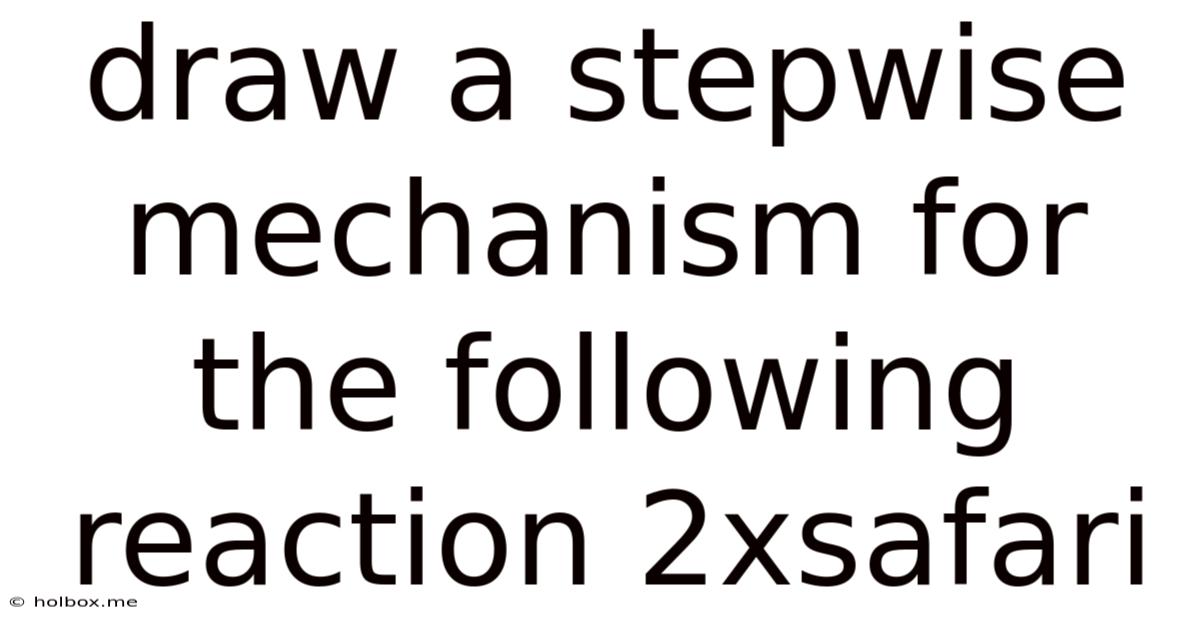Draw A Stepwise Mechanism For The Following Reaction 2xsafari
Holbox
May 08, 2025 · 5 min read

Table of Contents
Unveiling the Stepwise Mechanism: A Deep Dive into the 2XSafari Reaction (Hypothetical)
This article explores a hypothetical reaction, termed "2XSafari," focusing on elucidating its stepwise mechanism. Since "2XSafari" isn't a recognized chemical reaction, we'll construct a plausible reaction and dissect its mechanism, applying standard organic chemistry principles. This will provide a valuable template for understanding and illustrating reaction mechanisms in general. We will assume a reaction involving two hypothetical reactants, X and Safari, leading to a product P. The specifics of X and Safari will be defined to allow for a detailed and illustrative mechanism.
Understanding Reaction Mechanisms
Before diving into the 2XSafari mechanism, let's briefly review the importance of understanding reaction mechanisms. A reaction mechanism is a detailed, step-by-step description of how a chemical reaction occurs. It provides insights into:
- The order of events: What happens first, second, third, etc., during the reaction.
- The intermediates formed: Short-lived species formed during the reaction but not present in the overall stoichiometry.
- The transition states: High-energy states that molecules pass through during the conversion of reactants to products.
- The rate-determining step: The slowest step in the reaction, which governs the overall reaction rate.
- The reaction kinetics: The relationship between reactant concentrations and reaction rate.
Understanding the mechanism allows for:
- Prediction of reaction outcomes: By understanding the steps, we can predict products for similar reactions.
- Reaction optimization: Knowing the rate-determining step helps in improving reaction efficiency.
- Catalyst design: Mechanisms guide the design of catalysts to speed up reactions.
Hypothetical Reaction: 2XSafari
Let's define our hypothetical reaction:
2X + Safari → P
Where:
- X represents a hypothetical molecule containing a nucleophilic group (e.g., an alcohol or amine).
- Safari represents a hypothetical electrophilic molecule containing a leaving group (e.g., a halide or tosylate).
- P represents the final reaction product.
For the sake of this example, let's further specify X and Safari:
- X: A primary alcohol, CH₃CH₂OH (Ethanol)
- Safari: A primary alkyl halide, CH₃CH₂Br (Bromoethane)
This now gives us a more concrete reaction:
2CH₃CH₂OH + CH₃CH₂Br → P (Hypothetical reaction)
This reaction could potentially result in an ether formation, although this requires specific conditions that we will explore in the mechanism.
Stepwise Mechanism of the 2XSafari Reaction (Hypothetical)
This reaction likely proceeds through an SN2 (Substitution Nucleophilic Bimolecular) mechanism, involving several steps:
Step 1: Deprotonation of Ethanol
The first step involves the deprotonation of one molecule of ethanol by another, generating an ethoxide ion (CH₃CH₂O⁻) and a protonated ethanol molecule (CH₃CH₂OH₂⁺). This is an equilibrium reaction, favoring the reactants under neutral conditions.
CH₃CH₂OH + CH₃CH₂OH ⇌ CH₃CH₂O⁻ + CH₃CH₂OH₂⁺
Step 2: Nucleophilic Attack
The strongly nucleophilic ethoxide ion attacks the carbon atom bearing the bromine atom in bromoethane (Safari). This is a concerted step, where the bond between the carbon and bromine breaks simultaneously as the bond between the carbon and oxygen forms. This results in the formation of a new carbon-oxygen bond and the displacement of the bromide ion as a leaving group. This step is characterized by the formation of a high-energy transition state with a pentacoordinate carbon atom.
CH₃CH₂O⁻ + CH₃CH₂Br → [CH₃CH₂O---C---CH₃---Br]⁺ → CH₃CH₂OCH₂CH₃ + Br⁻
Step 3: Proton Transfer
The protonated ethanol molecule (CH₃CH₂OH₂⁺) donates a proton to the newly formed ethoxide ion, restoring the neutral diethyl ether molecule.
CH₃CH₂OCH₂CH₃ + CH₃CH₂OH₂⁺ → CH₃CH₂OCH₂CH₃ + CH₃CH₂OH
Overall Reaction:
The overall reaction, combining all three steps, is the formation of diethyl ether and a molecule of ethanol.
2CH₃CH₂OH + CH₃CH₂Br → CH₃CH₂OCH₂CH₃ + CH₃CH₂OH + Br⁻
Alternative Pathways and Considerations:
While the SN2 mechanism outlined above is the most plausible pathway for this hypothetical reaction, other possibilities exist depending on the specific nature of reactants X and Safari and the reaction conditions (solvent, temperature, presence of catalysts, etc.). For instance:
-
E2 Elimination: If strong base is present, instead of SN2 substitution, an E2 elimination reaction might occur. This would result in the formation of an alkene.
-
SN1 Reaction: An SN1 (Substitution Nucleophilic Unimolecular) mechanism is less likely in this case given the primary nature of the alkyl halide, but under specific conditions favoring carbocation formation, it becomes possible.
Factors Influencing the Reaction:
Several factors can influence the reaction rate and outcome:
- Solvent: Polar aprotic solvents (like DMSO or DMF) often favor SN2 reactions by stabilizing the transition state. Protic solvents can hinder the reaction.
- Temperature: Higher temperatures generally increase the reaction rate, but can also favor side reactions.
- Concentration of Reactants: Increasing the concentration of reactants increases the likelihood of collisions, hence faster reaction rates.
- Steric Hindrance: Bulky groups around the reaction center will slow down the SN2 reaction, potentially favouring alternative pathways.
- Leaving Group Ability: The ability of the leaving group to depart from the molecule affects the reaction rate. Good leaving groups (like halides) facilitate the reaction.
- Nucleophile Strength: Stronger nucleophiles react faster in SN2 reactions.
Conclusion:
This detailed explanation provides a framework for understanding and illustrating stepwise mechanisms in organic chemistry. The hypothetical 2XSafari reaction, while fictitious, allows for a comprehensive exploration of a typical SN2 mechanism and the various factors influencing its progression. Remember that understanding reaction mechanisms is critical for predicting reaction outcomes, optimizing reactions, and designing new catalytic systems. Adapting this methodology to other reactions, by carefully considering the nature of the reactants and reaction conditions, will allow for the successful elucidation of numerous other reactions. Always remember to consider potential alternative pathways and the influence of reaction parameters.
Latest Posts
Related Post
Thank you for visiting our website which covers about Draw A Stepwise Mechanism For The Following Reaction 2xsafari . We hope the information provided has been useful to you. Feel free to contact us if you have any questions or need further assistance. See you next time and don't miss to bookmark.